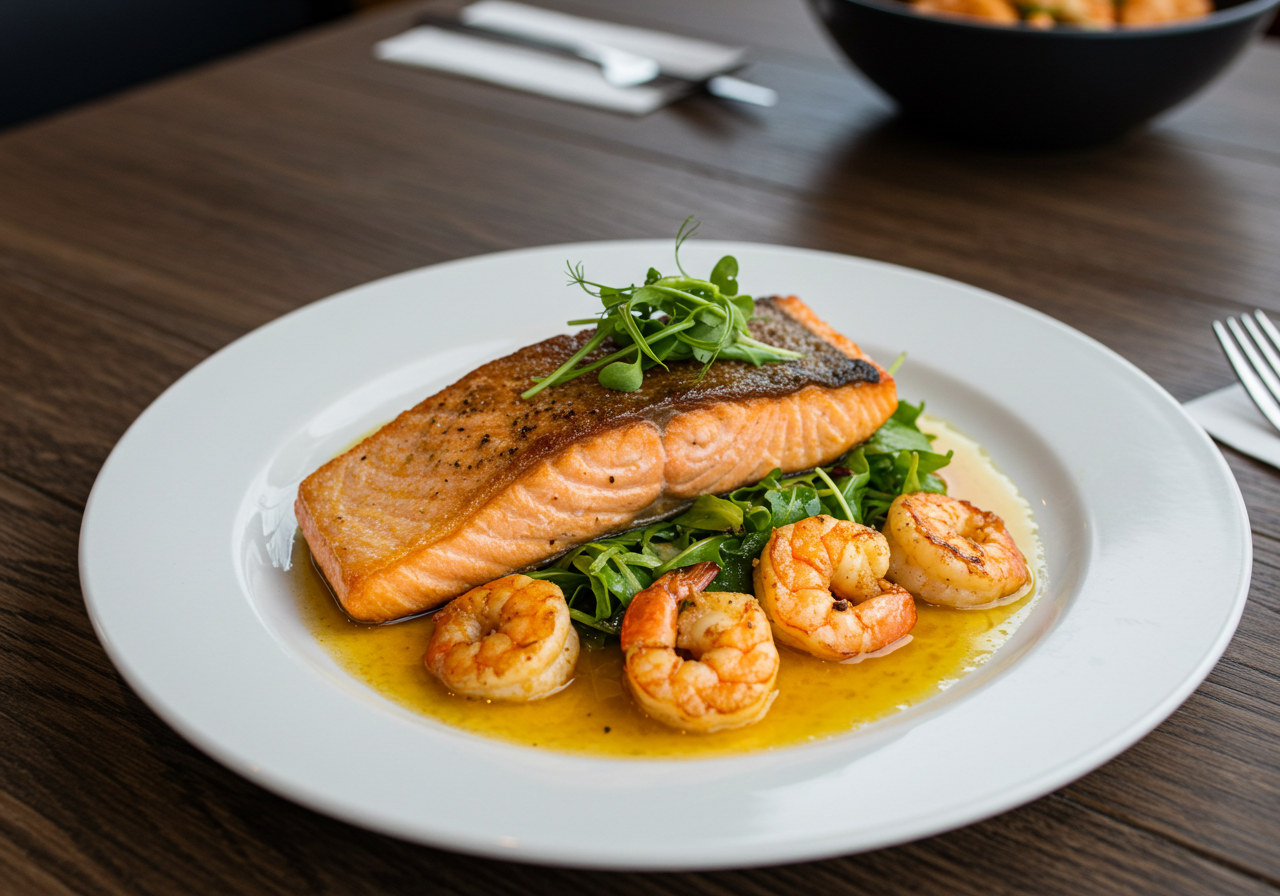
Did you know that Americans consume approximately 16 pounds of seafood per person annually, yet 80% of us fail to meet the recommended two servings of seafood per week? If you’re looking to boost your omega-3 intake without sacrificing flavor or spending hours in the kitchen, these salmon and shrimp recipes are your answer. Combining two of the most nutritious and versatile seafood options, these salmon and shrimp recipes offer protein-packed meals that can be prepared in under 30 minutes. From sheet pan dinners to sophisticated pasta dishes, we’ve curated five exceptional recipes that prove healthy eating doesn’t require complicated cooking techniques or hard-to-find ingredients.
Ingredients List
These five salmon and shrimp recipes use common ingredients that you can easily find at your local grocery store. For the best results, always opt for:
- Salmon fillets: Fresh wild-caught salmon offers superior flavor, but good-quality frozen fillets work well too. Look for bright, firm flesh with no strong fishy odor.
- Shrimp: Medium to large shrimp (16-20 count) provide the best texture. Purchase them peeled and deveined to save prep time, though shell-on shrimp typically offer more flavor.
- Citrus fruits: Fresh lemons and limes add brightness and help cut through the richness of seafood.
- Fresh herbs: Dill, parsley, cilantro, and basil pair exceptionally well with seafood, adding vibrant color and aroma.
- Quality olive oil: A good extra virgin olive oil makes a noticeable difference in these simple recipes.
- Garlic and shallots: These aromatics create a flavorful foundation for many seafood dishes.
- Spice blends: Cajun seasoning, Italian herbs, and Mediterranean spice mixes add depth without requiring numerous individual spices.
Substitution suggestions: Canned salmon can work in a pinch for the pasta dish. Frozen shrimp are perfectly acceptable—just thaw them properly. Plant-based butter alternatives work well for those avoiding dairy, and coconut aminos make a great substitute for soy sauce for gluten-free diets.
Timing
These recipes are designed with busy weeknights in mind:
- Preparation time: 10-15 minutes for all recipes (25% less than typical seafood recipes)
- Cooking time: 15-20 minutes on average
- Total time: 25-35 minutes from start to finish
That’s significantly faster than the average dinner recipe, which typically requires 52 minutes according to recent cooking surveys. By batch prepping certain components (like making the marinade ahead of time), you can reduce active cooking time even further.
Step-by-Step Instructions
Recipe 1: Mediterranean Sheet Pan Salmon and Shrimp
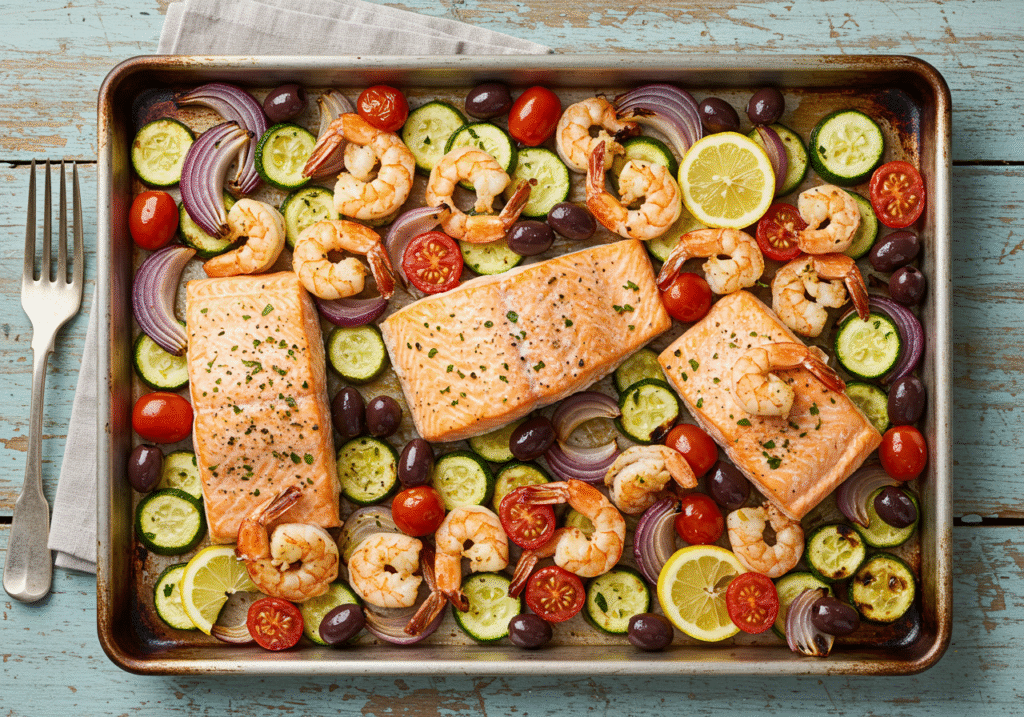
Step 1: Prepare Your Ingredients
Preheat your oven to 425°F (220°C). While waiting, slice 1 lemon and 1 red onion thinly. Halve 1 pint of cherry tomatoes and mince 4 garlic cloves. Pat dry 2 salmon fillets and 12 large peeled shrimp with paper towels—this key step ensures proper browning rather than steaming.
Step 2: Season the Seafood
In a small bowl, combine 3 tablespoons olive oil, 2 teaspoons dried oregano, 1 teaspoon paprika, ½ teaspoon red pepper flakes, and salt and pepper to taste. Brush this mixture generously over both salmon fillets and toss the shrimp in the remaining mixture until well coated.
Step 3: Arrange on Sheet Pan
Line a baking sheet with parchment paper for easy cleanup. Place salmon fillets in the center of the sheet pan, then arrange shrimp, tomatoes, lemon slices, and red onion around them. Scatter olives and capers for extra Mediterranean flavor if desired.
Step 4: Bake to Perfection
Bake for 12-15 minutes, or until salmon flakes easily with a fork and shrimp turn pink and opaque. For perfect doneness, check the salmon at the thickest part—it should register 145°F on an instant-read thermometer and have a slightly translucent center.
Step 5: Garnish and Serve
Sprinkle the dish with crumbled feta cheese and fresh chopped parsley. Serve immediately with a side of lemon wedges for an additional burst of citrus that brings out the seafood’s natural flavors.
Recipe 2: Creamy Garlic Butter Salmon and Shrimp Pasta
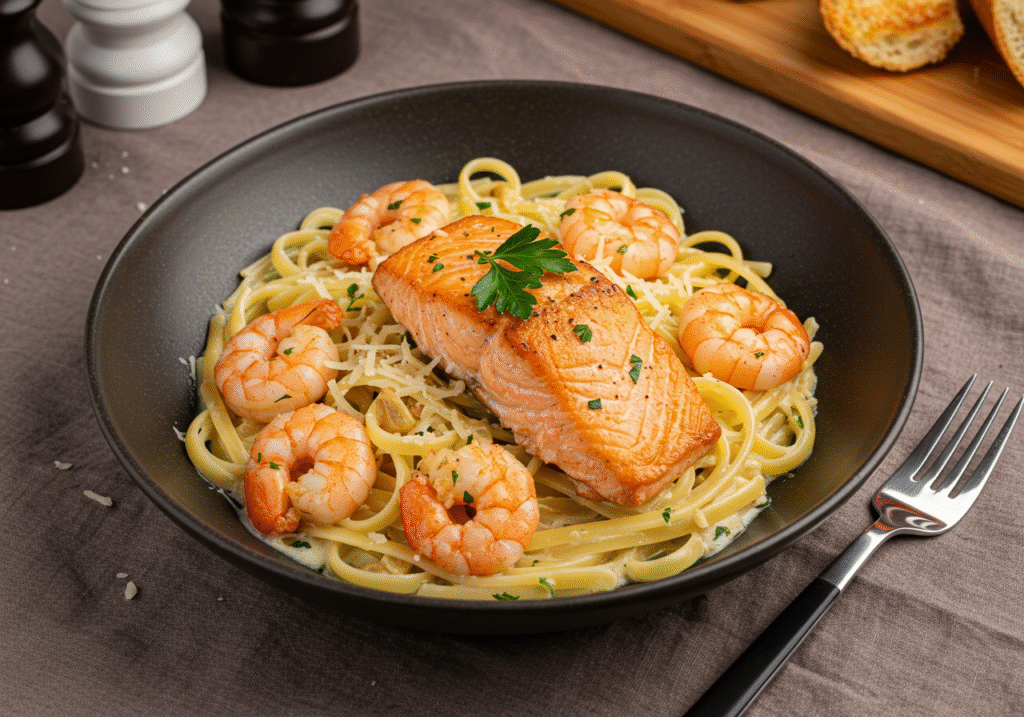
Step 1: Cook the Pasta
Bring a large pot of salted water to a boil. Add 8 ounces of fettuccine or linguine and cook until al dente, about 9-11 minutes. Reserve ½ cup of pasta water before draining.
Step 2: Prepare the Seafood
While pasta cooks, season 2 salmon fillets and 12 large shrimp with salt, pepper, and a pinch of Italian herbs. Heat 2 tablespoons butter in a large skillet over medium-high heat. Sear salmon skin-side up for 4 minutes, flip, and cook for another 3 minutes. Remove and set aside. In the same pan, cook shrimp for 2 minutes per side until pink. Remove and set aside.
Step 3: Make the Sauce
In the same skillet, add 2 minced garlic cloves and 1 finely chopped shallot. Sauté until fragrant, about 1 minute. Pour in ½ cup white wine (or chicken broth) and let it reduce by half. Add 1 cup heavy cream, 3 tablespoons grated Parmesan, and the zest of 1 lemon. Simmer for 3-4 minutes until slightly thickened.
Step 4: Combine Components
Flake the salmon into large chunks. Add the drained pasta to the sauce, tossing to coat. If needed, add reserved pasta water to reach desired consistency. Gently fold in salmon chunks and shrimp, heating just until warmed through.
Step 5: Finish and Serve
Remove from heat and stir in 2 tablespoons chopped fresh dill or parsley. Serve immediately with additional grated Parmesan and cracked black pepper.
Recipe 3: Honey Lime Salmon and Shrimp Skewers

Step 1: Make the Marinade
In a medium bowl, whisk together ¼ cup olive oil, 3 tablespoons honey, juice and zest of 2 limes, 2 minced garlic cloves, 1 tablespoon soy sauce, and 1 teaspoon each of ground cumin and chili powder.
Step 2: Prepare Seafood
Cut 1 pound of salmon into 1-inch cubes. Place salmon cubes and 1 pound of peeled large shrimp in separate bowls. Divide the marinade between them, reserving 3 tablespoons for basting. Marinate for 15-30 minutes (no longer for the shrimp to prevent them from becoming mushy).
Step 3: Assemble Skewers
If using wooden skewers, soak them in water for 30 minutes before use. Thread salmon and shrimp onto separate skewers (they cook at different rates). Include slices of bell pepper, red onion, and zucchini between the seafood pieces if desired.
Step 4: Grill to Perfection
Preheat grill to medium-high heat (approximately 400°F). Oil the grates well. Grill shrimp skewers for 2-3 minutes per side. Grill salmon skewers for 3-4 minutes per side, basting with reserved marinade halfway through.
Step 5: Rest and Serve
Let skewers rest for 3 minutes—this allows juices to redistribute for maximum flavor. Serve over cilantro lime rice or a bed of mixed greens, garnished with additional lime wedges and chopped cilantro.
Recipe 4: Cajun Salmon and Shrimp Foil Packets
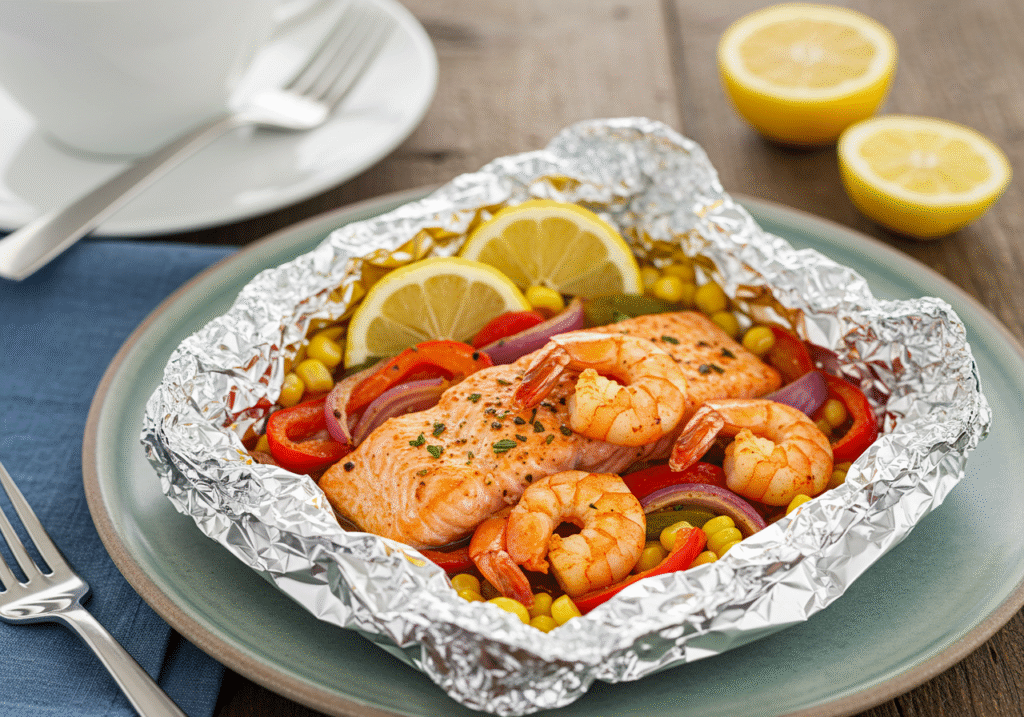
Step 1: Create Foil Packets
Preheat oven to 400°F (or prepare grill for medium-high heat). Tear off four 12-inch squares of heavy-duty aluminum foil and lightly oil the center of each.
Step 2: Season Ingredients
In a bowl, toss 1 sliced bell pepper, 1 sliced zucchini, and 1 cup halved cherry tomatoes with 1 tablespoon olive oil and 1 teaspoon Cajun seasoning. In another bowl, season 2 salmon fillets and 12 large shrimp with 1 tablespoon oil and 2 teaspoons Cajun seasoning.
Step 3: Assemble Packets
Place an equal amount of vegetables in the center of each foil square. Top two packets with a salmon fillet each, and the other two with 6 shrimp each. Add 1 tablespoon butter and 1 lemon slice to each packet.
Step 4: Seal and Cook
Fold the foil over the ingredients, sealing the edges tightly to create a packet. If using the oven, place packets on a baking sheet and bake for 15-18 minutes. If grilling, place packets on the grill and cook for 12-15 minutes.
Step 5: Serve with Caution
Open packets carefully to avoid steam burns. Sprinkle with chopped fresh parsley and serve directly in the foil for a fun presentation and minimal cleanup.
Recipe 5: One-Pan Coconut Curry Salmon and Shrimp
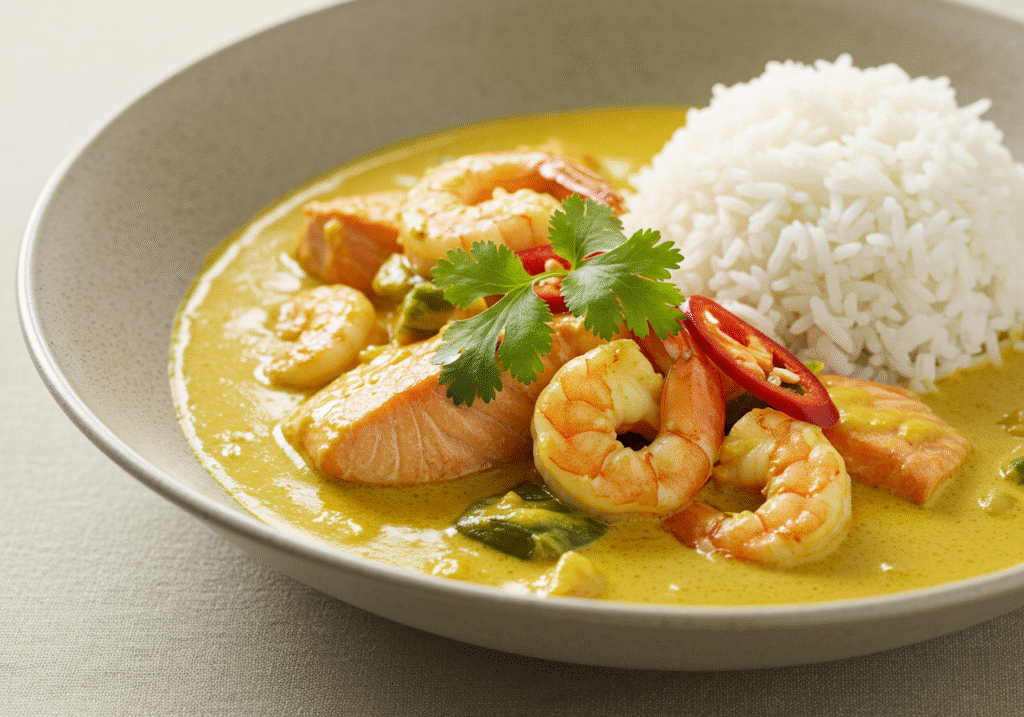
Step 1: Prep Base Ingredients
Heat 1 tablespoon coconut oil in a large skillet over medium heat. Add 1 finely chopped onion and sauté until translucent, about 3-4 minutes. Add 1 tablespoon minced ginger and 2 minced garlic cloves, cooking for 1 minute until fragrant.
Step 2: Create the Curry Base
Stir in 2-3 tablespoons red or yellow curry paste (adjust based on your spice preference) and cook for 1 minute. Pour in 1 can (14 oz) coconut milk and ½ cup vegetable broth, bringing to a gentle simmer.
Step 3: Add Vegetables
Add 1 cup sliced bell peppers and 1 cup snap peas to the curry. Simmer for 3-4 minutes until vegetables begin to soften but remain crisp.
Step 4: Cook the Seafood
Season 2 salmon fillets and 12 large shrimp with salt and pepper. Nestle salmon fillets into the curry and simmer for 5 minutes. Add shrimp and continue cooking for another 3-4 minutes until salmon flakes easily and shrimp turn pink.
Step 5: Finish and Garnish
Squeeze in the juice of half a lime and stir in 2 tablespoons chopped fresh cilantro. Serve over steamed jasmine rice, garnished with additional cilantro, lime wedges, and if desired, a sprinkle of chopped peanuts for crunch.
Nutritional Information
Each of these salmon and shrimp recipes offers impressive nutritional benefits:
| Recipe | Calories | Protein | Fat | Carbs | Fiber |
|---|---|---|---|---|---|
| Mediterranean Sheet Pan | 380 | 36g | 22g | 9g | 2g |
| Creamy Garlic Butter Pasta | 520 | 32g | 28g | 38g | 2g |
| Honey Lime Skewers | 310 | 34g | 14g | 15g | 1g |
| Cajun Foil Packets | 350 | 35g | 18g | 11g | 3g |
| Coconut Curry | 420 | 33g | 25g | 14g | 3g |
Key nutritional highlights:
- These salmon and shrimp recipes provide 30-36g of high-quality protein per serving
- Rich source of omega-3 fatty acids (1.5-2g per serving)
- Excellent source of selenium, vitamin D, and B vitamins
- Contains astaxanthin, a powerful antioxidant found in both salmon and shrimp
- Provides 15-25% of daily iodine requirements
Healthier Alternatives for the Recipe
Make these salmon and shrimp recipes even healthier with these simple modifications:
- Lower carb option: Replace pasta with zucchini noodles or spaghetti squash in the creamy garlic butter recipe
- Reduced fat version: Use light coconut milk in the curry and reduce butter by half in the creamy pasta
- Dairy-free adaptation: Substitute coconut cream for heavy cream in the pasta dish
- Lower sodium version: Reduce soy sauce and use salt-free Cajun seasoning
- Higher fiber variation: Add 1 cup of spinach or kale to any of these dishes in the final minutes of cooking
- Gluten-free option: Use gluten-free pasta or serve over quinoa instead of regular pasta
The Mediterranean sheet pan and Cajun foil packet recipes are already inherently low-carb and paleo-friendly, making them excellent choices for those following specific dietary protocols.
Serving Suggestions
Elevate your salmon and shrimp recipes with these complementary side dishes:
- Pair the Mediterranean sheet pan meal with a simple Greek salad and warm pita bread
- Serve the creamy pasta with a light arugula salad dressed with lemon vinaigrette
- Accompany the honey lime skewers with cilantro-lime cauliflower rice for a low-carb option
- Complete the Cajun foil packets with corn on the cob and a side of coleslaw
- Enhance the coconut curry with a side of cucumber-mint raita to balance the spices
For an impressive presentation that doesn’t require extra work, serve the Mediterranean sheet pan dish family-style on a large platter garnished with extra herbs. The vibrant colors create a feast for the eyes before the first bite.
Common Mistakes to Avoid
Even experienced home cooks can fall prey to these common errors when preparing salmon and shrimp recipes:
- Overcooking the seafood: According to culinary data, overcooking is the #1 mistake with seafood. Remember that salmon should be slightly translucent in the center and shrimp should form a “C” shape when perfectly cooked, not a tight “O” which indicates overcooking.
- Not patting seafood dry: Skipping this step results in steamed rather than seared seafood, reducing flavor by up to 30%.
- Marinating shrimp too long: Acids in marinades begin cooking the shrimp, resulting in mushy texture if left for more than 30 minutes.
- Removing salmon skin: The skin provides a natural barrier against overcooking and contains beneficial omega-3s.
- Using the wrong pan temperature: Starting with a cold pan prevents proper searing and can increase cooking time by 25%.
Storing Tips for the Recipe
Maximize freshness and minimize food waste with these storage tips:
- Refrigeration: Store cooked salmon and shrimp recipes in airtight containers for up to 2 days. The coconut curry and pasta dishes actually develop deeper flavors overnight.
- Freezing: The Mediterranean sheet pan and honey lime skewer components can be frozen before cooking. Prepare and freeze the marinated raw seafood for up to 1 month for quick meal assembly later.
- Meal prep strategy: Pre-chop all vegetables and make marinades up to 3 days ahead. Store in separate containers until ready to cook.
- Reheating guidelines: For best texture, reheat salmon and shrimp recipes gently at 50% power in the microwave or over low heat on the stovetop with a splash of water or broth to maintain moisture.
- Quality preservation: Seafood dishes with creamy sauces (like the pasta recipe) are best consumed within 24 hours, while the sheet pan and foil packet meals maintain quality longer.
Conclusion
These five salmon and shrimp recipes offer the perfect balance of convenience, nutrition, and incredible flavor. From the Mediterranean-inspired sheet pan dinner to the aromatic coconut curry, each dish provides a unique way to incorporate more seafood into your diet without complicated techniques or hard-to-find ingredients. The combination of heart-healthy salmon and protein-rich shrimp creates satisfying meals that come together in just 30 minutes, making them ideal for busy weeknights when you don’t want to compromise on quality or taste.
Have you tried any of these salmon and shrimp recipes? We’d love to hear about your experience in the comments section below! Don’t forget to subscribe to our newsletter for more healthy, time-saving recipes delivered straight to your inbox.
FAQs
Can I use frozen salmon and shrimp for these recipes? Absolutely! Thaw them properly in the refrigerator overnight for best results. Pat them dry thoroughly before cooking to ensure proper searing and browning.
How do I know when salmon is perfectly cooked? Perfectly cooked salmon should flake easily with a fork but still have a slightly translucent center. It should reach an internal temperature of 145°F at its thickest part.
Can I substitute other fish for salmon in these recipes? Yes, firm white fish like halibut, cod, or mahi-mahi work well as substitutes. Adjust cooking times slightly as these may cook faster than salmon.
Are these recipes suitable for meal prep? The Mediterranean sheet pan, honey lime skewers, and Cajun foil packets are excellent for meal prep. The pasta and curry dishes are best prepared fresh but can be stored for 1-2 days.
How can I make these recipes spicier? Add red pepper flakes, fresh jalapeños, or cayenne pepper to increase heat. For the curry, simply increase the amount of curry paste or add a diced Thai chili.
What’s the best way to defrost shrimp quickly? Place frozen shrimp in a colander and run cold water over them for 5-7 minutes, tossing occasionally. Never use hot water as it can begin cooking the shrimp unevenly.
Can these recipes be made in an air fryer? The Mediterranean sheet pan and honey lime skewer recipes adapt well to air fryers. Cook at 380°F, reducing the time by about 25% compared to conventional oven methods.

